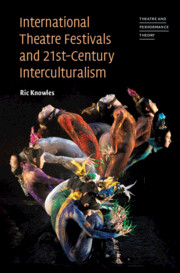35 results
Introduction
-
- Book:
- International Theatre Festivals and Twenty-First-Century Interculturalism
- Published online:
- 11 January 2022
- Print publication:
- 16 December 2021, pp 1-26
-
- Chapter
- Export citation
Illustrations
-
- Book:
- International Theatre Festivals and Twenty-First-Century Interculturalism
- Published online:
- 11 January 2022
- Print publication:
- 16 December 2021, pp xi-xiii
-
- Chapter
- Export citation
Chapter 3 - The Curated Live-Arts Festival
-
- Book:
- International Theatre Festivals and Twenty-First-Century Interculturalism
- Published online:
- 11 January 2022
- Print publication:
- 16 December 2021, pp 112-155
-
- Chapter
- Export citation
Chapter 5 - The Intracultural Transnational
-
- Book:
- International Theatre Festivals and Twenty-First-Century Interculturalism
- Published online:
- 11 January 2022
- Print publication:
- 16 December 2021, pp 191-229
-
- Chapter
- Export citation

International Theatre Festivals and Twenty-First-Century Interculturalism
-
- Published online:
- 11 January 2022
- Print publication:
- 16 December 2021
Work Cited
-
- Book:
- International Theatre Festivals and Twenty-First-Century Interculturalism
- Published online:
- 11 January 2022
- Print publication:
- 16 December 2021, pp 271-296
-
- Chapter
- Export citation
Conclusion
-
- Book:
- International Theatre Festivals and Twenty-First-Century Interculturalism
- Published online:
- 11 January 2022
- Print publication:
- 16 December 2021, pp 230-248
-
- Chapter
- Export citation
Contents
-
- Book:
- International Theatre Festivals and Twenty-First-Century Interculturalism
- Published online:
- 11 January 2022
- Print publication:
- 16 December 2021, pp vii-viii
-
- Chapter
- Export citation
Dedication
-
- Book:
- International Theatre Festivals and Twenty-First-Century Interculturalism
- Published online:
- 11 January 2022
- Print publication:
- 16 December 2021, pp v-vi
-
- Chapter
- Export citation
Copyright page
-
- Book:
- International Theatre Festivals and Twenty-First-Century Interculturalism
- Published online:
- 11 January 2022
- Print publication:
- 16 December 2021, pp iv-iv
-
- Chapter
- Export citation
Notes
-
- Book:
- International Theatre Festivals and Twenty-First-Century Interculturalism
- Published online:
- 11 January 2022
- Print publication:
- 16 December 2021, pp 249-270
-
- Chapter
- Export citation
Chapter 4 - Fringe Festivals and Other Alternatives
-
- Book:
- International Theatre Festivals and Twenty-First-Century Interculturalism
- Published online:
- 11 January 2022
- Print publication:
- 16 December 2021, pp 156-190
-
- Chapter
- Export citation
Chapter 2 - Destination Festivals and the International Festival Circuit
-
- Book:
- International Theatre Festivals and Twenty-First-Century Interculturalism
- Published online:
- 11 January 2022
- Print publication:
- 16 December 2021, pp 72-111
-
- Chapter
- Export citation
Preface
-
- Book:
- International Theatre Festivals and Twenty-First-Century Interculturalism
- Published online:
- 11 January 2022
- Print publication:
- 16 December 2021, pp ix-x
-
- Chapter
- Export citation
Acknowledgements
-
- Book:
- International Theatre Festivals and Twenty-First-Century Interculturalism
- Published online:
- 11 January 2022
- Print publication:
- 16 December 2021, pp xiv-xvi
-
- Chapter
- Export citation
Chapter 1 - Indigeneity, Festivals, and Indigenous Festivals
-
- Book:
- International Theatre Festivals and Twenty-First-Century Interculturalism
- Published online:
- 11 January 2022
- Print publication:
- 16 December 2021, pp 27-71
-
- Chapter
- Export citation
Index
-
- Book:
- International Theatre Festivals and Twenty-First-Century Interculturalism
- Published online:
- 11 January 2022
- Print publication:
- 16 December 2021, pp 297-314
-
- Chapter
- Export citation
Contents
-
- Book:
- The Cambridge Companion to International Theatre Festivals
- Published online:
- 22 May 2020
- Print publication:
- 11 June 2020, pp vii-viii
-
- Chapter
- Export citation
Copyright page
-
- Book:
- The Cambridge Companion to International Theatre Festivals
- Published online:
- 22 May 2020
- Print publication:
- 11 June 2020, pp iv-iv
-
- Chapter
- Export citation
Part II - International Festivals Around the Globe
-
- Book:
- The Cambridge Companion to International Theatre Festivals
- Published online:
- 22 May 2020
- Print publication:
- 11 June 2020, pp 85-253
-
- Chapter
- Export citation



